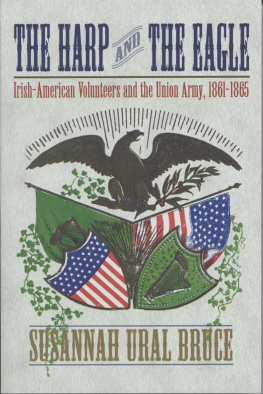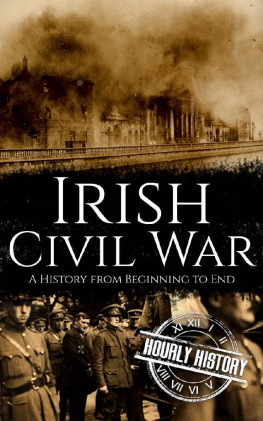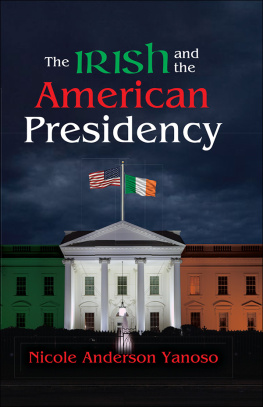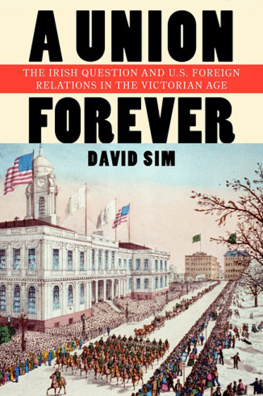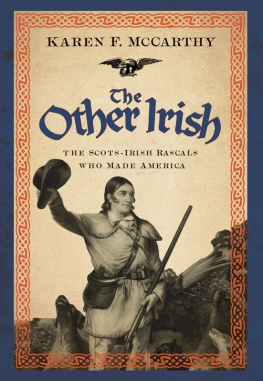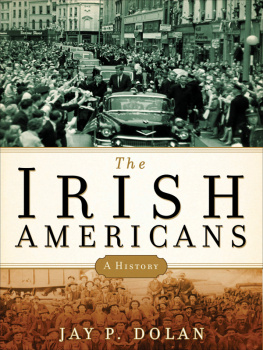Thank you for buying this ebook, published by NYU Press.
Sign up for our e-newsletters to receive information about forthcoming books, special discounts, and more!
Sign Up!
About NYU Press
A publisher of original scholarship since its founding in 1916, New York University Press Produces more than 100 new books each year, with a backlist of 3,000 titles in print. Working across the humanities and social sciences, NYU Press has award-winning lists in sociology, law, cultural and American studies, religion, American history, anthropology, politics, criminology, media and communication, literary studies, and psychology.
The Harp and the Eagle
NEW YORK UNIVERSITY PRESS
New York and London
www.nyupress.org
2006 by New York University
All rights reserved
Library of Congress Cataloging-in-Publication Data
Bruce, Susannah Ural.
The harp and the eagle : Irish-American volunteers and the Union
Army, 1861-1865 / Susannah Ural Bruce.
p. cm.
Includes bibliographical references and index.
ISBN-13: 978-0-8147-9939-0 (cloth : alk. paper)
ISBN-10: 0-8147-9939-6 (cloth : alk. paper)
ISBN-13: 978-0-8147-9940-6 (pbk. : alk. paper)
ISBN-10: 0-8147-9940-X (pbk. : alk. paper)
1. United StatesHistoryCivil War, 18611865Participation,
Irish American. 2. United States. ArmyHistoryCivil War,
18611865. 3. Irish American soldiersHistory19th century. 4.
Irish AmericansHistory19th century. 5. CatholicsUnited
StatesHistory19th century. I. Title.
E540.I6B78 2006
973.7410899162dc22 2006016125
New York University Press books are printed on acid-free paper,
and their binding materials are chosen for strength and durability.
Manufactured in the United States of America
c 10 9 8 7 6 5 4 3 2 1
p 10 9 8 7 6 5 4 3 2 1
Acknowledgments
I like to read biographies of writers I admire because I want to copy their routines and style to improve my skills, and I think a dark part of me likes to know that they suffer, too. But I learn something else from their work. No author would ever get published without a lot of help along the way. In a sense, this book is as much the work of my friends and colleagues as it is mine. Well, at least the good parts.
This began as a doctoral dissertation, though it has changed tremendously from that first incarnation. The core of the project was shaped by my doctoral adviser, Donald J. Mrozek, professor of history at Kansas State University, who remains a valued mentor and treasured friend. Contributing to this, as well, were my committee members Peter B. Knupfer, Lou F. Williams, and Sue Zschoche of the K-State History Department and Harald E. L. Prins, K-State professor of anthropology. All of them remain friends and supporters to this day, and Harald, in particular, has been wonderful about debating the finer points of this work as I polished my arguments. While researching and writing the dissertation, I taught as a full-time lecturer in the Department of History at Sam Houston State University and earned a tenure-track position there when I received my Ph.D. My colleagues supported the project in every way possible and it is a privilege to continue working with them today. I would like to thank especially Jim Olson and Robert Bruce, who read and offered valuable suggestions on the manuscript, as well as Caroline Crimm, Charlann Morris, and Nancy Sears for their constant support. I am grateful, too, to my students, including one of our best graduate students, Justin Baxley, who dug up some outstanding nineteenth-century articles that contributed to this work. Thanks go to the SHSU Newton Gresham Library staff, especially Betty Craig, as well as the Kansas State University Library staff, especially John Johnson and Lori Fenton. Travel funds from the SHSU history department, directed first by Jim Olson and later by Terry Bilhartz, helped with the research, as did a generous grant from the Irish American Cultural Institute, its president John Walsh, and the Friendly Sons of St. Patrick.
Over the years, the dissertation evolved into a book and that manuscript evolved into a much stronger one. Many of the final revisions were thanks to the suggestions of Kerby Miller and I am forever indebted to him for directing me to a wealth of Irish soldiers letters and helping me to embrace the complexity of this work. Similar guidance came from Randall Miller, another reader of the manuscript and a scholar who aided it tremendously with his detailed suggestions for revisions. Both Kerby and Randall remain postdoctoral mentors who push my understanding of Irish-American history and the U.S. Civil War to new levels. I would also like to thank the additional anonymous reader of the manuscript for his or her helpful suggestions.
Guiding this evolution, too, was Carol Reardon. I cant recall exactly when we first met, but my first extended contact with her was during her Civil War battlefield staff rides while I was a West Point Summer Fellow in 2002. The entire fellowship was outstanding, but Carols contributions at Manassas, Antietam, and Gettysburg were unforgettable. She hasnt been able to shake me since. Throughout this work Carol served as a sounding board for my ideas. She took time out of her schedule to return with me to Antietam and Gettysburg to make sure I had the Irish units in the right place, and then she read and reread the sections of the manuscript relating to those battlefield discussions. And shes never made a penny for all of that work. True, there have been the odd dinner or two, but I will never be able to repay my debt. Thank you, Carol. In addition to Kerby, Randall, and Carol, I would like to thank the following colleagues who shared sources or helped strengthen my arguments: Ruth-Ann M. Harris, Lawrence Kohl, Bruce Vandervort, Larry Bland, Arnold Schrier, Dennis Showalter, the late Russell F. Weigley, Jeffrey Grey, and Chris Samito.
As you research a book, the material doesnt always take you where you think it will. This, of course, is good and the way historians should work, but it means that a lot of archivists and librarians have to be ready to help you along the way as you request just one more box to fill in the missing piece of your story. For their help in this part of the journey, I would like to thank the staff at the National Archives and Records Administration and the Library of Congress in Washington, DC, Dan Rolph and Kerry McLaughlin at the Historical Society of Pennsylvania, Shawn Weldon at the Philadelphia Archdiocesan Historical Research Center, Derek W. Weil and Beth Becker at The Civil War and Underground Railroad Museum of Philadelphia, and Jim Mundy, Director of the Library and Historical Collections at the Union League in Philadelphia. Thanks go to Michael Comeau and John Hannigan at the Massachusetts State Archives and Kim Nusco and Kate DuBose at the Massachusetts Historical Society. In New York I had the pleasure of working in a number of repositories, but would like to especially thank Chris Karpiak at the New York State Library in Albany and Bill Cobert and the outstanding staff at the American Irish Historical Society in New York City, as well as Henry F. White, Jr., historian of the Society of the Friendly Sons of St. Patrick in the City of New York, whose papers are held at the American Irish Historical Society. While I was visiting the city, authors Peter Quinn and Terry Golway were kind enough to take time from their busy schedules to discuss my work and offer their suggestions. In Illinois, I would like to thank Chuck Cali, John Reinhardt, and David A. Joens of the Illinois State Archives, Leigh A. Gavin, Debbie Vaughan, and Rob Medina of the Chicago Historical Society, and Cheryl Schnirring of the Abraham Lincoln Presidential Library. Thanks go to John White and Devon Lee of the Southern Historical Collection at the University of North Carolina at Chapel Hill, Miriam Meislik and Michael J. Dabrishus of the Archives and Special Collections Department of the University of Pittsburgh, and Ryan Meyer at the U.S. Army Military History Institute at Carlisle Barracks, Pennsylvania.

